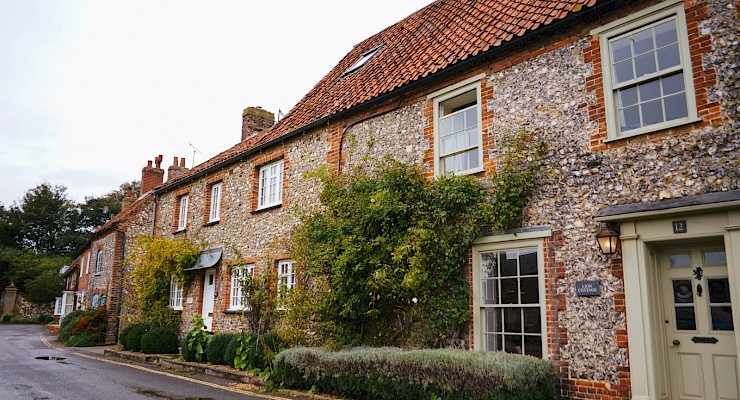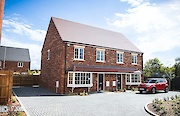


Head of Content

Mortgage Advisor & Director

Deposits are a key part of the mortgage process, and in most cases, you are unlikely to be approved without one. But how much deposit do you need, where can the funds come from, and what kind of deal can you expect based on the amount you have? Here we have answered these questions and more.
What is a mortgage deposit?
A mortgage deposit a sum of money you pay upfront when taking out a mortgage to buy a property. This payment covers a percentage of the purchase price, typically 5-10% or higher, with the amount you are borrowing on the mortgage covering the rest of the cost.
The initial deposit you put down becomes equity in the property and the amount that you hold will increase as you pay off your mortgage over the agreed term.
The amount of deposit you can put down will have a direct effect on the quality of the mortgage deals you are offered, as it will determine the loan-to-value (LTV) ratio.
You can work out your LTV by dividing the amount you need to borrow, with the deposit factored in, by the property value and multiplying the total by 100. Borrowers with low LTVs (or high deposits) are typically seen as lower risk and offered more favourable rates.
Example: If you were buying a property with a purchase price of £200,000 and have a £20,000 deposit, you would need to borrow £180,000 and have an 80% LTV ratio.
How much deposit do you need to get a mortgage?
To get a residential mortgage, the minimum amount of deposit you would usually need is 5% of the property’s purchase price, but some lenders may ask you for 10%. The more deposit you can put down, the better the chances of you securing a favourable mortgage rate.
Mortgage products with 5-10% deposit requirements (90-95% LTV mortgages) tend to have some of the highest rates on the market, but deals steadily improve as LTVs decline. The very best interest rates tend to kick in at the 60% LTV mark (or 40% deposit).
Although 5-10% deposit is the minimum most mortgage lenders will accept, there are scenarios where you might only be approved with a higher amount. They include:
- If you are buying an investment property
- You have a history of bad credit
- You need to use a specialist mortgage lender
You might need to use a specialist lender for all kinds of reasons, such as being self-employed with limited proof of income or needing to borrow based on a higher income multiple than what is available to you on the high street. The amount of deposit you would need in these circumstances can vary from one lender’s product range to the next.

Find a better mortgage deal with Teito today
Where your mortgage deposit can come from
Most mortgage lenders like the deposit to come from personal savings or investments, but there are other acceptable sources too. The table below lists the most common mortgage deposit sources, how desirable they are to lenders, and how you can evidence them.
Deposit Source | Acceptability | How to prove your deposit |
Personal savings or investments | All UK lenders will accept personal savings or investments as a deposit source | 3-6 months of statements from the savings/investment account showing the funds building up over time |
Most mortgage lenders will accept if the donor is immediate family but only a minority if it is a gifted from a non-relative, such as a close personal friend | Donors must state in writing that the funds are a gift and they will have no interest in the property. Financial statements from donor and beneficiary confirming funds have changed hands may also be requested | |
Sale of a property or other assets | Most lenders accept the proceeds from a property sale, as long as the funds aren’t under charge from someone else. Proceeds from the sale of other assets usually acceptable, but extra scrutiny to rule out money laundering is possible | A memorandum of sale along with bank statements showing the funds entering account. Latest mortgage statement and conveyancer’s letter may also be requested if the asset was a property |
Loans | A small minority of lenders accept an unsecured loan as a deposit | A copy of the loan agreement and bank statements showing the funds entering bank account |
Inheritance/Redundancy | Most lenders will accept as long as the funds have been paid out | Written confirmation from employer/solicitor may be requested, along with statements to confirm funds have arrived in bank account |
Overseas funds | Some lenders will be happy with this source as long as the funds come from an established bank or overseas account | Account statements from a trackable source, covering 3-6 months |
Cash | Only a few lenders will accept cash deposit, and the amount of deposit you can submit in this format will likely be capped, sometimes at no more than a few hundred pounds | Any kind of legal paper trial to show where the cash originated from, such as pay stubs or invoices |
Gambling winnings | Some lenders will be happy with this, but keep in mind that if your bank statements show a history of excessive gambling you might not qualify for a mortgage at all | Receipts confirming the winnings amount, along with bank statements showing the funds entering account |
A small minority of lenders will accept proceeds generated from cryptocurrency, such as Bitcoin, as a deposit | Paperwork, documents and bank statements showing how you acquired and sold your holdings |
As you can see from the table above, some deposit sources are more widely accepted by lenders than others - speak to a broker if you are concerned that yours might be declined.
How deposit amount affects mortgage rates
The table below shows examples of the kind of mortgage interest rate you can expect based on the amount of deposit you have and the resulting LTV ratio.
Loan-to-Value (LTV) Ratio | Approximate Mortgage Rate |
4.90% to 6.49% | |
85% (15% deposit) | 4.73% to 6.34% |
80% (20% deposit) | 4.73% to 6.34% |
70-75% (25-30% deposit) | 4.33% to 6.34% |
60% or lower (40% deposit plus) | 4.23% to 6.34% |
These mortgage rates are based on the product range of a leading high street lender at the time of writing (June 2024). They are representative of the current residential market, but are subject to change.
How to calculate your mortgage repayments
Working out what your mortgage repayments could look like with the amount of deposit you have factored in is straightforward. Simply deduct the amount of deposit you have from the property’s purchase price to arrive at the amount you need to borrow as a starting point.
Next, enter the amount you need to borrow into our calculator below along with an interest rate, term length and repayment type to get your repayment results:
Now that you have an idea of how much your mortgage could cost with your deposit amount factored in, you can compare rates and deals from lenders across the market for free on Teito, and access support from a broker - get started here.
Getting a mortgage with no deposit

Although the vast majority of mortgage lenders will only consider you for a mortgage if you have at least 5% deposit to put down, there are ways to get approved with none at all.
Below you will find a summary of the options to consider if you have no deposit:
100% LTV mortgages
These are very rare and are offered by a small minority of lenders. One of the most popular options for borrowers who need a 100% LTV mortgage is Skipton’s ‘Track Record’ mortgage, which is aimed at renters who haven’t owned a property in the last three years.
The eligibility criteria for Skipton’s no-deposit mortgage is as follows:
- Applicants must have clean credit
- Need evidence of making 12 monthly rent payments in a row in the last 18 months
- A maximum term length of 35 years
- Maximum borrowing of 4.49 times salary
- A maximum property value of £600,000
Interest rates for 100% LTV mortgages such as this Skipton Building Society offering are relatively high and carry a greater risk of falling into negative equity. Since they are not the only way to get a mortgage with no deposit, it’s a good idea to speak to a mortgage broker to review every possible alternative before you consider making an application.
Guarantor and family support mortgages
If you have a family member or close friend who is willing to support you financially, there are guarantor and other types of family support mortgages that could help you buy a property with no deposit of your own to put down, but not all lenders offer these arrangements.
With these types of mortgages, the person who is supporting you must either secure your mortgage against a property they own and hold the required amount of equity in, or place enough savings into an account held by the lender to cover the deposit amount.
Guarantor and family support mortgages can help people get on the property ladder who would otherwise struggle to save enough deposit, but there are few caveats:
- Guarantors must agree to pay the mortgage if the homeowner defaults
- Certain lenders will expect you to have at least some deposit of your own
- Guarantors must also pass eligibility and affordability checks
- Some lenders will only allow immediate family members to support
Right to Buy mortgages
This scheme will only be an option if you are buying a council house or housing association property that you are living in, but if this is the case, it is possible to get a mortgage through the Right to Buy or Right to Acquire scheme with no immediate deposit to put down.
Mortgage applicants who are using this scheme get a government discount on the property’s purchase price, and this can often be used to cover all of the deposit.
Borrowed and gifted deposits
One way to get a mortgage with no immediate deposit is to borrow one in the form of an unsecured loan, or be gifted one by a close friend or family member. Only a small minority of lenders will approve mortgages where the deposit is an unsecured loan, but options are more plentiful for gifted deposits, especially if the donor is immediate family.
Schemes that can help you raise a deposit
If you are struggling to raise the minimum amount of deposit, there are a number of schemes you could apply for. Some of these initiatives can boost your chances of securing a mortgage with a lower deposit amount, while others can help you with your savings.
The schemes currently available are as follows:
- Mortgage Guarantee Scheme: This government initiative has increased the number of 95% LTV mortgages on the market, which means there are more options for borrowers who are applying for home finance with less than 10% deposit.
- First Homes Scheme: This scheme is aimed at first-time buyers who are purchasing new build properties. It is possible to get approved with just 5% deposit but the First Homes Scheme also offers a substantial discount on the purchase price (30-50% off its market value), so the deposit funds you have could go much further.
- Deposit Unlock: This is another initiative that gives additional options to homebuyers with 5% deposit to put down. Deposit Unlock mortgages are for first-time buyers who are purchasing a new build property from one of the participating housebuilders, which include Redrow, Barratt Homes and Bellway.
- Help to Buy ISAs: Help to Buy ISAs are designed to help you save for a mortgage deposit. The government will add an additional 25% to your savings pot, tax free, when the time comes to buy your home. Unfortunately this scheme is now closed to new applicants, but those who took one out before the deadline can claim their government bonus until 2030. Those who don’t have an existing Help to Buy ISA may wish to research Lifetime ISAs, as these are considered a viable alternative.
Buy-to-let mortgage deposit requirements
Buy-to-let mortgages come with higher deposit requirements than residential and the minimum you will need is 20% of the property’s value (80% LTV). The interest rate you are offered should begin to improve at 75% LTV, with the best deals kicking in around 60% LTV.
You may be asked for slightly more deposit if:
- You have bad credit
- Are a first-time landlord
- Are buying the property through a limited company
- Are applying for a multi-property mortgage
If you are concerned you don’t have enough deposit, see our guide to low deposit buy-to-let mortgages to find out what options could be available to you.
How much do you need for a commercial mortgage?
Deposit requirements for a commercial mortgage are generally between 20% and 40% of the property’s value, but there is some room for flexibility in this corner of the market. Commercial mortgage lending is unregulated and therefore mortgage providers can offer finance on a case-by-case basis. This means that you could theoretically be approved with less than the typical minimum amount, provided the lender believes the investment is strong.
Why choose Teito for your mortgage needs?
Now that you have a better idea of the amount of deposit you will need, you can compare mortgage rates for free on Teito and speak to one of our expert brokers if you need a little help.
Here are just some of the reasons our customers choose use for their mortgage needs:
- You can access the latest mortgage rates in seconds
- Our brokers can access exclusive deals for all LTVs
- We are 5-star rated on leading review websites
- You can secure an agreement in principle in minutes
Ready to compare mortgage rates for free and take advantage of a free, no-obligation chat with one of our mortgage brokers? Get started here.
FAQs
Technically speaking, they are two different things but you don’t need to save up two separate deposits. On the day of contract exchange, you'll pay 5-10% of the property price to the seller's solicitor, known as the exchange deposit, to complete the transaction.
Your mortgage deposit is the total amount you are paying upfront for the property in addition to the mortgage. This becomes equity in your property and is made up of the same funds (5-10%) you used for the exchange, plus any extra you are putting down.
Choosing an Adviser
Selecting a qualified and experienced mortgage adviser is of great importance. To choose a suitable adviser, evaluate their qualifications, experience, and reputation, and ensure they are regulated by the Financial Conduct Authority (FCA).
Read reviews from previous clients and make sure they provide a clear explanation of the products and services they offer, as well as the fees and charges associated with them.
Last updated 6 June 2024
06 June 2024
Updated rates table, added FAQs component, section titled 'Why choose Teito for your mortgage needs?' and content about 40% and 50% LTV mortgages





























































